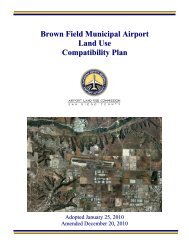Draft EA - San Diego International Airport
Draft EA - San Diego International Airport
Draft EA - San Diego International Airport
Create successful ePaper yourself
Turn your PDF publications into a flip-book with our unique Google optimized e-Paper software.
SAN DIEGO INTERNATIONAL AIRPORT – PROPOSED RUNWAY 9 DISPLACED THRESHOLD<br />
4.5 Air Quality<br />
The primary sources of guidance for assessing potential air quality effects are FAA Orders 1050.1E and the Air<br />
Quality Procedures for Civilian <strong>Airport</strong>s and Air Force Bases (<strong>Airport</strong> Air Quality Handbook). 11<br />
Typically, an<br />
emissions inventory is prepared for each reasonable alternative, including the No Action alternative.<br />
Additional analyses, including dispersion modeling or roadway intersection hot spot analyses, are not typically<br />
required if the estimated emissions of each criteria pollutant would not exceed thresholds listed in the general<br />
conformity regulations. Information presented in the <strong>Airport</strong> Air Quality Handbook can be used to determine<br />
whether an NAAQS assessment 12<br />
should be performed for a proposed action.<br />
4.5.1 REGULATORY STANDARDS AND CRITERIA<br />
The CAA requires federal agencies to ensure that their actions conform to the appropriate SIP. Conformity is<br />
defined as demonstrating that a project or action conforms to the SIP’s purpose of eliminating or reducing the<br />
severity and number of violations of the NAAQS, and achieving expeditious attainment of such standards.<br />
Federally funded and approved actions at airports are subject to the U.S. EPA’s general conformity regulations.<br />
The U.S. EPA has published a final rule regarding general conformity determinations. 13<br />
The final rule includes<br />
annual emissions thresholds for nonattainment areas and maintenance areas that trigger the need for a<br />
general conformity determination, and defines projects that are generally excluded from general conformity<br />
requirements.<br />
A conformity determination is required if one of the following occurs: (1) the total direct and indirect<br />
pollutant emissions 14 resulting from a project are above de minimis 15 emissions threshold levels specified in the<br />
conformity regulations, or (2) pollutant emissions from the project would be regionally significant (i.e., the<br />
project would contribute 10 percent or more of the region’s total emissions for a criteria pollutant). A<br />
conformity determination is not required if the differences in emissions between the proposed action and the<br />
no action alternative are below the applicable de minimis threshold levels. If a conformity determination is<br />
required, the regulation identifies the approaches for showing that an action/project conforms to the<br />
appropriate SIP.<br />
11<br />
12<br />
13<br />
14<br />
15<br />
U.S. Department of Transportation, Federal Aviation Administration, Air Quality Procedures for Civilian <strong>Airport</strong>s and Air Force Bases, Report<br />
No. FAA-AEE-97-03, Washington, DC, April 1997, including the addendum, Report No. FAA-AEE-04-03, September 2004.<br />
When a Proposed Action could cause or contribute to an exceedance of the NAAQS, pollutant concentrations are estimated for criteria<br />
pollutants of interest through air dispersion modeling. The FAA’s Emissions and Dispersion Modeling System (EDMS) incorporates<br />
algorithms from the U.S. EPA’s AERMOD dispersion model.<br />
U.S. Environmental Protection Agency, 40 Code of Federal Regulations Part 93, Determining Conformity of Federal Actions to State or<br />
Federal Implementation Plans, Subpart B, November 30, 1993, as amended.<br />
Total direct and indirect emissions are the sum of the emissions increases and decreases associated with a proposed project, or the “net”<br />
change in emissions anticipated to occur as a result of the proposed project (40 CFR 93.152).<br />
Emissions are so small as to be negligible or insignificant. If a project/action has de minimis emissions, a conformity determination/<br />
NAAQS assessment pursuant to the Clean Air Act Amendments of 1990 is not required (40 CFR 93.153c).<br />
<strong>Draft</strong> <strong>EA</strong><br />
Environmental Consequences<br />
[4-15]
















